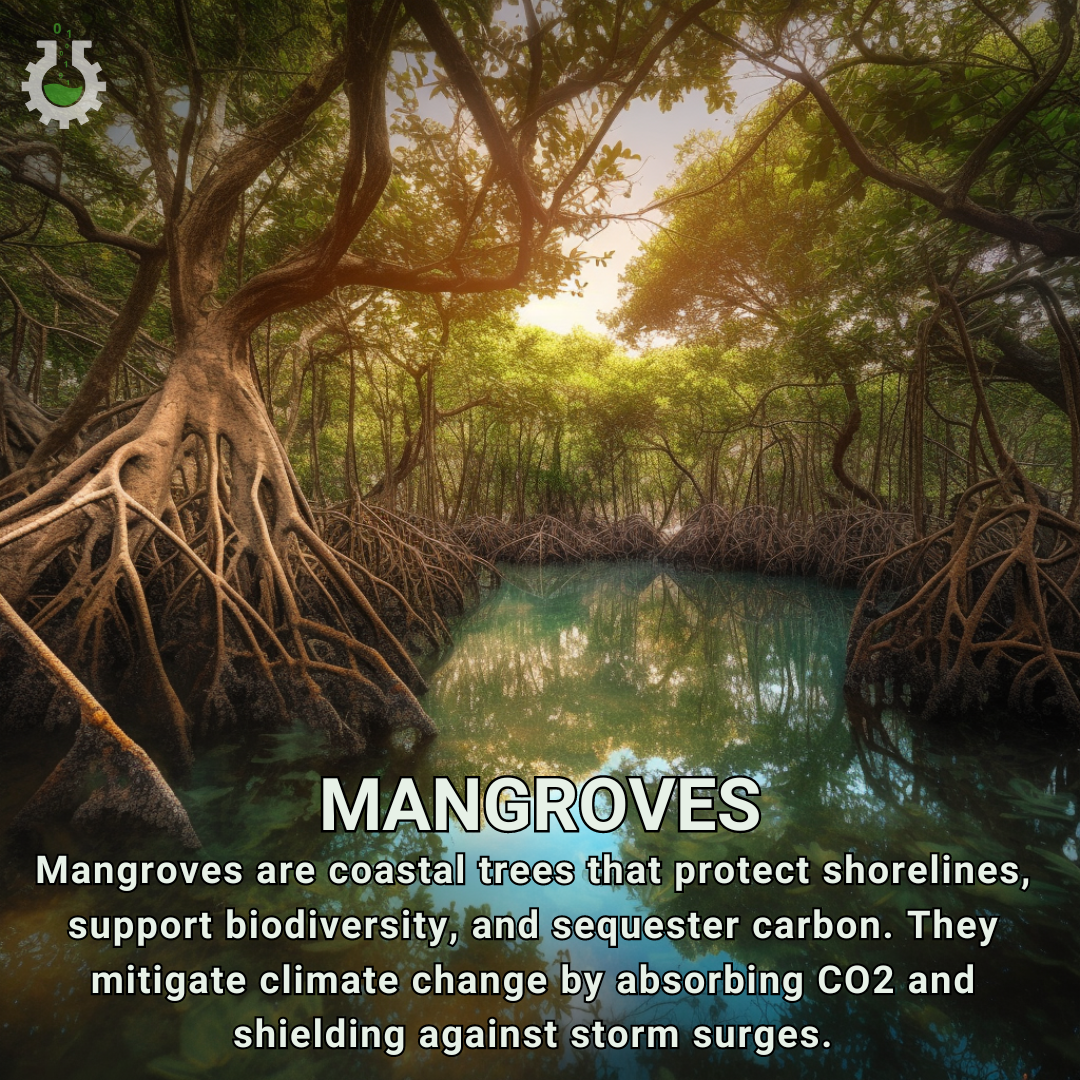May 31, 2024
Climate Change Poster Collection of the Day – Mangroves
Book a Demo
Today’s Climate Change Poster Collection highlights Mangroves, the coastal guardians of our planet, are remarkable ecosystems that play a crucial role in mitigating climate change. These unique trees and shrubs thrive in saline coastal environments, forming dense forests along tropical and subtropical shorelines. Mangroves are often referred to as “blue carbon” ecosystems because of their extraordinary ability to sequester carbon dioxide from the atmosphere and store it in their biomass and the surrounding soil. In fact, mangroves can store up to four times more carbon than terrestrial forests, making them one of the most efficient natural carbon sinks on the planet. Their intricate root systems not only stabilize shorelines and protect against erosion but also provide a habitat for a diverse array of marine life, supporting fisheries and biodiversity. Mangroves act as natural barriers against storm surges and rising sea levels, reducing the impact of extreme weather events on coastal communities. However, despite their immense ecological and climate benefits, mangroves are under threat from deforestation, land reclamation, and pollution. The loss of mangroves not only releases stored carbon back into the atmosphere, exacerbating climate change, but also diminishes their capacity to protect coastal areas and support marine ecosystems. Conservation and restoration of mangrove forests are essential strategies in the fight against climate change. By preserving these vital ecosystems, we can enhance carbon sequestration, protect biodiversity, and safeguard coastal communities from the adverse effects of a changing climate. Efforts to restore degraded mangrove areas and promote sustainable management practices are crucial steps towards harnessing the full potential of mangroves in our global climate strategy. As we continue to seek innovative solutions to combat climate change, the protection and restoration of mangrove forests stand out as a powerful and natural approach that benefits both the environment and human societies.
The multifaceted benefits of mangroves extend beyond their impressive carbon sequestration capabilities. These coastal forests are biodiversity hotspots, hosting a myriad of species that rely on their unique habitat for survival. Fish, crabs, shrimp, and mollusks find sanctuary in the tangled roots of mangroves, which serve as nurseries for many marine species. This biodiversity not only supports local fisheries but also contributes to global marine health. Birds, mammals, and insects also depend on mangrove ecosystems, making them critical to the overall health of coastal environments. Furthermore, mangroves play a vital role in water quality regulation. Their root systems filter pollutants and trap sediments, preventing them from reaching the open ocean. This natural filtration process helps maintain the clarity and quality of coastal waters, benefiting both marine life and human populations who depend on these waters for their livelihoods.
The socio-economic benefits of mangroves are equally significant. Coastal communities around the world depend on mangroves for their livelihoods, whether through fishing, tourism, or the collection of resources such as timber and honey. The protection provided by mangroves against natural disasters like hurricanes and tsunamis is invaluable, often making the difference between life and death for those living in vulnerable coastal areas. The economic value of these protective services is immense, saving billions of dollars in potential damage and recovery costs. Recognizing the importance of mangroves, various international initiatives and agreements have highlighted the need for their conservation and restoration. Programs like the United Nations’ REDD+ (Reducing Emissions from Deforestation and Forest Degradation) aim to incentivize developing countries to protect and restore their mangrove forests by providing financial rewards for verified emission reductions. Such initiatives underscore the global recognition of mangroves as a key component in the fight against climate change.
However, the path to effective mangrove conservation is fraught with challenges. Coastal development, aquaculture expansion, and pollution continue to threaten these vital ecosystems. Addressing these threats requires a multifaceted approach that includes stringent regulations, community engagement, and international cooperation. Local communities must be at the forefront of conservation efforts, as their traditional knowledge and vested interest in the health of mangrove forests are invaluable. Education and awareness campaigns can also play a crucial role in changing perceptions and encouraging sustainable practices. Innovative restoration techniques, such as the use of drones for seed dispersal and the implementation of mangrove-friendly aquaculture practices, are being explored to enhance the success of restoration projects.
Mangroves are indispensable allies in our battle against climate change, offering unparalleled benefits in carbon sequestration, biodiversity support, coastal protection, and socio-economic stability. The conservation and restoration of mangrove forests are not merely environmental imperatives but are also crucial for the well-being of millions of people worldwide. As we navigate the complexities of climate change, investing in the protection and restoration of mangroves presents a natural and effective strategy that promises significant returns for both the planet and its inhabitants. By embracing and enhancing our efforts to safeguard these coastal treasures, we can make meaningful strides towards a more sustainable and resilient future.
Discover an inspiring collection of climate change poster.



